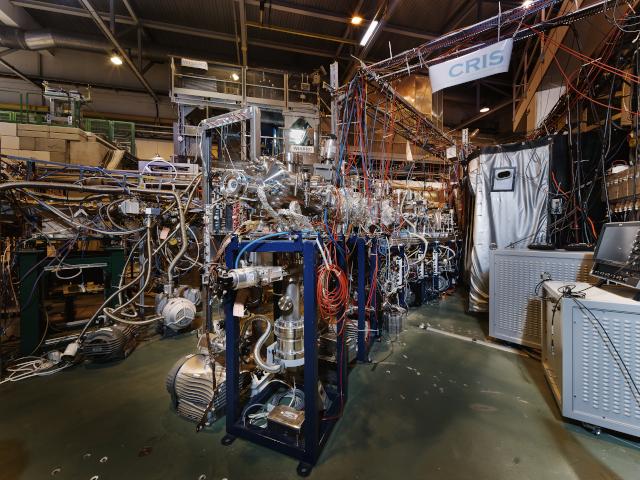
Credit: CERN
In nuclear physics so-called magic number are such nuclear proton and/or neutron numbers, for which the nucleus is more stable compared to neighboring isotopes on the nuclear chart. Researchers in both experimental and theoretical nuclear physics from University of Jyväskylä, Finland, took part of international research team, which studied the nuclear charge radii of potassium isotopes. Isotopes were studied by using the collinear resonance ionization spectroscopy technique. The results indicated that the potassium isotope with a neutron number of 32 does not conform with criteria of magic neutron number. The results were published in Nature Physics journal on January 2021.
Far from the stable isotopes which we know well from the periodic table, in region of the so-called exotic nuclei, an extreme ratio of protons and neutrons lead to the emergence of new phenomena which test our understanding of the nuclear forces.
One well known feature of these forces is that some nuclei with certain number of protons and/or neutrons are more stable than their neighboring isotopes. We refer to these numbers as magic numbers. They lead to longer half-lives and among others, a smaller size than would be expected for a non-magic nucleus.
In the mass region of the potassium isotopes, 32 was proposed as a new magic number for neutrons. The experimental study of these special regions of the nuclear chart is crucial to unveil new phenomena, and through comparison with state-of-the-art nuclear theory, test how well we understand them.
However, in practice, these isotopes can only be produced at accelerator facilitates, and there only in minute samples. This drives continuous developments in experimental techniques, for increased efficiency and sensitivity to the nuclear properties we wish to measure.
Modification to setup to measure nuclear charge radius of 52K
In this research researchers performed laser spectroscopy studies on the exotic potassium isotopes using the Collinear Resonance Ionization Spectroscopy (CRIS) technique at CERN, ISOLDE.
“For the measurement of the potassium isotope with 33 neutrons (52K), we modified our setup to increase the selectivity of the method, by detecting the decay of this isotope, thus reducing the background noise introduced by stable species. This allowed for the measurement of nuclear charge radius of 52K”, says post doctoral researcher Agota Koszorus from the University of Liverpool, who is now based at the University of Jyväskylä.
“If the size of this isotope was significantly larger than its proposed magic neighbor, 51K, we would have confirmed the magic nature of the neutron number 32. However, our results show a continuously increasing trend, implying that 32 neutrons don’t have a special stabilizing affecting on the nuclear size”, she concludes.
On theory side, the nuclear structure of potassium isotopes were modeled with two different theoretical approaches, namely with the nuclear density functional theory (DFT) and the coupled cluster (CC) theory.
“The DFT is an ideal method for heavier nuclei, whereas CC is more suitable for light and medium mass nuclei. The potassium region offers an ideal meeting ground to test these approaches simultaneously. Both theoretical methods need information about the nuclear interactions. For this purpose, state-of-the art nuclear structure models were applied: The DFT calculations employed highly successful Fayans energy density functional and CC calculations used the latest ab-initio chiral potential”, says Associate Professor Markus Kortelainen from the Department of Physics at the University of Jyväskylä.
While both theoretical approaches reproduced the general experimental trend of charge radius isotopic shifts, some shortcomings were noted. The DFT results showed a notable overestimation of charge radius staggering between neighboring odd and even neutron number isotopes, whereas the CC calculations had difficulties to reproduce experimental trend in heavier isotopes. These observations urge to further improve present nuclear structure models.
###
Link to research in Nature Physics, January 2021: Charge radii of exotic potassium isotopes challenge nuclear theory and the magic character of N ?=?32 | Nature Physics
For further information:
Post doctoral researcher Agota Koszorus, [email protected] (in English)
Associate Professor Markus Kortelainen, [email protected] (also in Finnish)
The Faculty of Mathematics and Science
Communications Specialist Tanja Heikkinen, [email protected], +358 50 472 1162
https:/
Media Contact
Agota Koszorus
[email protected]
Original Source
https:/
Related Journal Article
http://dx.




